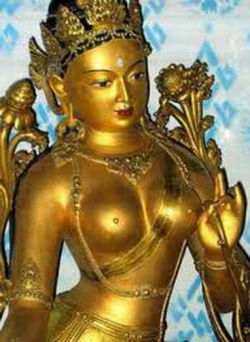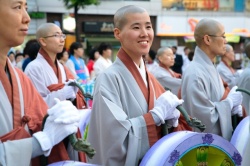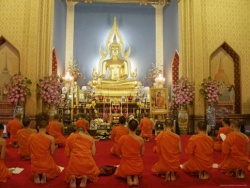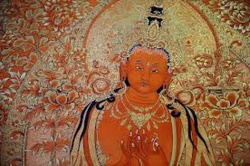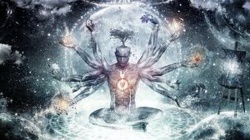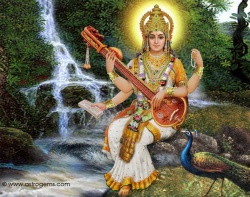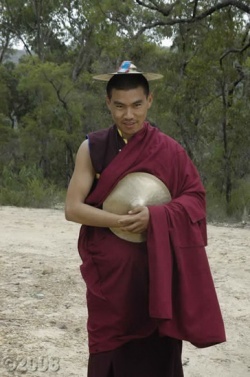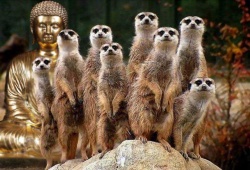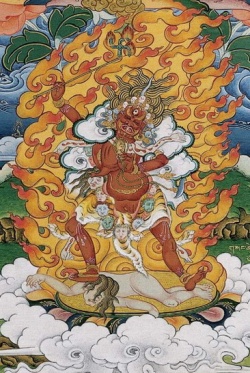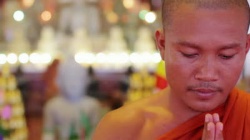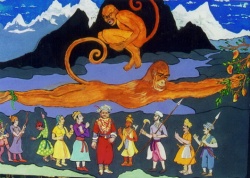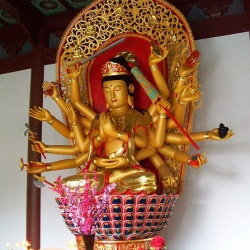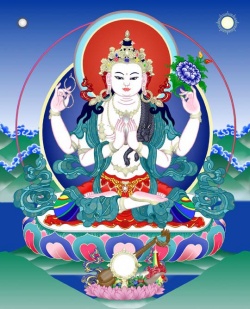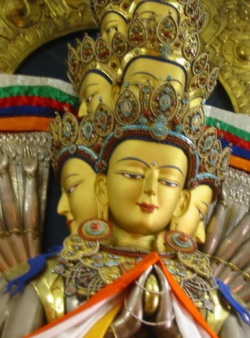Female deities
The female deities of Buddhism are of many types.
There are buddhas in female form and goddesses who are bodhisattvas. There are also historical figures such as lineage founders, and they all can function as deities.
There are also yidams and dharma protectors in peaceful, semi-wrathful or wrathful form.
The dakini, a special type of deity, is discussed separately.
What follows is not a definitive catalogue, by any means.
The best known of the female Tibetan Buddhist deities is Tara.
Arya Sanskrit for Exalted or [[Noble] Tara, is best known in two forms, White and Green.
Tara is a Buddha who is depicted in various ways that reflect her activity.
She can be peaceful or semi-wrathful; alone or surrounded by 21 manifestations or aspects.
Besides Green Tara and her several aspects that are generally designated by colour, some other distinctive female deities are:
Achi Chokyi Drolma, is the peaceful white Drikung Kagyu protector on her blue mule or, sometimes, a blue-maned snow lion.
Chintamani: The Wishful-filling Jewel form of Tara who is also a protector.
Dorje Yudronma: (Vajra Turquoise Lamp) the Longchen Nyinthig lineage-protector who bears an arrow tied with five-coloured silks in her right hand and a divination mirror in her left.
In the life of yogi, Jigme Gyalwai Nyugu, she appeared when he was starving and offered him food.
Ekajati or Ekadzati (Tib. Ralchikma or Tsechikma) is the Nyingma Dzogchen protector of mantras (Ngag Sungma) and mind-treasure (Tib. terma) whose epithet, "One Braid" (or, plait) refers to her initially terrifying appearance since she has only one eye, one tooth, one breast and so on.
These (Skt. Maha-pancha Devi) appear in the entourage of White Vajradarana.
They include the source of all earthly wealth as Pratishara (Tib. So.sor trang. ma), who is yellow with three faces and ten hands;
Sita Sitavani) red with four hands, Mayuri who is green with one face and two hands,
Sahasra.pramardana, blue with one face and six hands, and Mantra manu dharani, black with one face and four hands.
Kalasiddhi was one of the consorts of Guru Rinpoche.
Kurukulla is a 4-armed dancing red Tara, an archer whose bow made of flowers relates to the subjugation of ego and the use of love/attraction in the service of dharma.
Hrih is her seed syllable and her mantra:
A possible origin? Karaikal is a town near Pondicherry, Tamil Nadu, India.
Punitavatiyar (Karaikalam.maiyar) was an early 7th century siddhari who requested that Lord Shiva divest her of the burden of her beautiful form.
She was transformed into a crone to be able to devote herself completely.
Kwan Yin (Perceiver of Sounds) Cantonese: Goong Yam is a Chinese form of the bodhisattva, Avalokiteshvara that is considered to be female.
In Japanese, she is called Kannon or Shokanzeon Bosatsu bosatsu = bodhisattva;] in Korean, Kwanseum Bosal or Kwan Um.
Professor Yu Chun-fang, wrote the interesting "Ambiguity of Avalokites'vara and Scriptural Sources for the Cult of Kuen-yin in China" article which is no longer found online.
Her thesis is supported not only by one of the most gorgeously spectacular so-called Kuan Yin images, in which we clearly see the male origin, is a Chinese 10th-century life-sized image of painted wood known as The Water and Moon Kuan-Yin Bodhisattva at the Nelson-Atkins Museum in Kansas City, Missouri, USA.
and The Creation of Goddess of Mercy ... that relates how she was once a princess (Chin. miao shan,) one of three sisters.
Tired of the politics and conflict of palace life, she resolves to become a hermit and eventually benefits beings by becoming one of the Immortals/a bodhisattva,
Lamanteri is the Mongolian, 8-armed, semi-wrathful form of Green Tara who is sometimes depicted with the 21 aspects of the Praises to Tara surrounding her.
Machig Lapdron: White, dancing dakini, sky-clad but for her bone ornaments, holding a medium-sized drum in her raised right hand. Magzor Gyalmo (Queen of the Army) is the younger sister who attends Palden Lhamo (Skt. Shri Devi.)
She rides a horse, attended by animal-headed dakinis.
Mandarava: considered a speech emanation of Vajravarahi, she is the first wife of Padmasambhava.
Besides her and Yeshe Tsogyal (Dechen Gyalmo) who function as deities, there are other consorts.
Marichi (Ozer Chenma) is reddish-gold with 8 arms.
She is the embodiment of sunrise or dawn. As a form of Tara, she is depicted standing, one pair of hands holding a needle and thread.
She is also identified with Vajravarahi (Dorje Pa'mo.)
Her most widely found image is the one with three faces, one of which is that of a sow, in which she drives a cart pulled by seven swine.
Marici's seven-swine cart may derive from the Indian myth that describes Surya's vehicle as drawn by seven horses.
Her practice may also derive from that of the Vedic dawn goddess, Ushas.
She is also comparable to the Greek goddess, Eos, who daily went out to rouse both Day and Night in her chariot drawn by a number of horses.
The multiple animals might relate to the fact that in ancient times, the sun appeared rather differently, accompanied by lesser lights.
The very promise of dawn, Marichi, "who holds the night," is invoked by travelers for protection from robbers and other hazards of the road:
Marichi alone.
Tantric Buddhists tell of Marichi's determination in the manner of Tara.
Taoists see her as Queen of Heaven, and the Japanese, as Amaterasu, the sun goddess.
Her origin lies in early Indian scriptures such as The Laws of Manu (Skt. Manava Dharma Shastra) and the Puranas, where Marichi is one of 10 Prajapatis or primal parents /chief of the Maruts produced from the mind of Brahma.
In this male aspect, Marichi is father of Surya, the sun and (with his wife Sambhuti) also of Kashyapa 'Old Tortoise Man' one of the seven primordial sages.
Thus, Marici, the beam of divine light that initiates creation of the physical world is not only illumination in a physical but also in the spiritual sense.
This 'illuminating' aspect of Marichi (Ozer Chenma: Queen of Light) is emphasized in an 17th century tangka of the Karma Kagyu at Himalayan Art where she is crowned by a stupa, and instead of driving, she is seated on a great sow with her seven piglets.
In the above link, an accompanying Sakya verse emphasizes her ability to dispel the fears of the night.
Sometimes animals other than piglets are depicted drawing her chariot.
(The third [[[Wikipedia:male|male]]] incarnation of the Jain founder is also called Marichi.)
Manimekhala "Jewel-girdled." Protector of seafarers, this South Indian Buddhist deity is also associated with lightning. She was popularized in Burma and Thailand.
Nairatmya 'One Absent-of-any-Self' is a sky-blue or dark-blue yidam and the consort of Hevajra.
The wife of Marpa the Translator, and mentor of Milarepa was named for her.
Palden Lhamo: She is the dark blue protector and only female among the Eight Guardians of the Law (Dharma Protectors) who is also Mahakali.
Her Sanskrit name Shri Devi means Great Lady, ie. Lady Goddess; Okkin Tungri to northern Mongolians.
Prajnaparamita (Yum Chenmo) embodies the Supreme Wisdom of the Emptiness Teaching.
She is golden and is readily identified by the books that sit atop the lotuses, one on each side of her, at the level of her head.
These sutras after which she is named are called by Nagarjuna (2nd century CE,) The Mother of Buddhas.
Sakya (Tib. pron. Sacha) Dema or Belmo Sakya Devi: See Guru Rinpoche's consorts.
Salgye Du Dalma: Dakini who affords protection and insight during sacred sleep/dream yoga.
"She who clarifies beyond conception" sits on a blue four-petaled lotus.
She is seen as a luminous drop (Skt. bindu, Tib. tigle).
Samantabhadri (Kuntuzangmo) is the yum or consort of the ultimate Buddha (as bodhisattva Samantabhadra is considered in some traditions.)
She is pure white or light, in contrast with his darkness.
See Yeshe Tsogyal, below.
Sengdongma, Lion-face Dakini, is a wrathful manifestation of Padmasambhava Guru Rinpoche who eliminates obstacles. Sinhavaktra: Dark blue Lion-head Dakini dispels obstacles to enlightenment. She holds a broad-bladed knife and skull cup.
Sitapatra (White Parasol,) also called Ushnisha-sitatapatra, is a protector described in the Shurangama Sutra.
The embodiment of the white parasol of royalty that appears over Buddha as a symbol of glory, her image is often mistaken for that of 1,000-armed Chenrezi.
She is described as having 1,000 faces, arms and legs.
Each of the eleven depicted heads has three eyes, and there is one in each palm and sole.
Her right hands hold dharma wheels and her left hold arrows, except for the one holding the parasol representing the protection she offers.
Her central faces are white like her body, but those to the right are yellow, and the left faces are green.
The ones facing to the rear (that we do not see) are described as red.
The two uppermost heads are blue.
Sukhasiddhi: (Tib. Dewai Ngod'up) Power-of-Bliss, a consort of Guru Padmasambhava, and founder of a lineage.
Tseringma is the protector of Bhutan.
The embodiment of Mount Chomolhari, she is chief among the 5 Longlife sisters.
Usnisha-vijaya (Nepali, Bijaya) (Tib. Tsug.tor Nam.par Gyel.ma) This is shortened to Namgyal or Namgyelma.
She is an 8-armed longevity deity, who also stands for the Mother of All Buddhas.
Like all Buddhist deities, she is essentially a manifestation of Emptiness acting as a bodhisattva.
She is able to bestow longevity on beings not for selfish reasons, but for the purpose of helping all others towards enlightenment.
She is a purification deity as well, invoked in the presence of the dead, and she is also invoked as a means of settling disputes.
Vajravidarana is a purification deity who holds a vishwarupa (double-dorje) and a bell with a similar handle.
In white form (Tibetan: dor.je nam.par jom.pa kar.po) she is the Indian goddess Sita, who has transcended her role as a worldy hero (her tale of suffering is told in Valmiki's Ramayana) to heal the afflictions of humankind, especially disease and other bodily conditions.
As Sitala, she was once associated with exorcising the cause of smallpox.
The Vajravidarana cleansing ceremony is a powerful spiritual aid to expunge or split open (Skt. darana) to release the mental and physical poisons lying at the root of suffering.
Vajrayogini (Dorje Naljorma): Slightly wrathful red dancing goddess with flowing black hair.
One aspect is known as Kechari, another is Vajravarahi, associated with the Kagyu school.
From an interview with Jetsun Sakya Kushog:
Q: Are there similarities and/or differences between the various traditions of Kachoma (Vajrayogini)?
A: I think in the Gelugpa the Vajrayogini practice is very similar to ours, because it comes from the Sakyas.
Maybe there are different lamas with different sets of sadhanas, different ways of teaching, some of them more detailed, but it comes from Sakya, so it is very much the same.
The Kagyupa's Vajrayogini is actually not Vajrayogini.
They call it Vajrayogini nowadays, especially among Westerners, but in fact it is Vajravarahi.
In Tibetan it is called Dorje Phagmo, and not Naro Kacho.
Therefore, the Kagyu practice is not Vajrayogini.
Q: Are they very different?
A: They are different, but both Vajravarahi and Vajrayogini are Chakrasamvara tantric practices and originally come from Naropa.
Naro Kacho means that it comes from Naropa.
Vishvamata: Consort of Kalachakra.
She is yellow, with 4 faces each with 3 eyes. The 8 hands hold: a curved knife, a hook, a small drum, a mala, a skull cap, a lasso, a lotus flower and a jewel.
Yeshe Tsogyal (form of Samantabhadri or Kuntuzangmo) legendary spiritual consort of Padmasambhava (Guru Rinpoche) considered a dakini (Sky Dancer by Dowman is her story) and mind emanation of Vajravarahi/Saraswati.
Said to have had a perfect memory, she was a concealer of Guru Rinpoche's treasures (termas.) She is said to have lived 211 years before attaining the rainbow body.
More about Kuan Yin and Tara in John Blofeld's Bodhisattva of Compassion: The Mystical Tradition of Kuan Yin (Boston: Shambala Publications, 1977) and Martin Wilson's In Praise of Tara: Songs of the Saviouress (Boston: Wisdom Publications, 1996) respectively.
- The word deity is understood in a unique way by Buddhist practitioners; it is used for lack of a better word.
Human beings are given to superstition, and undoubtedly there are those who are inclined to view a, some, or all deities as "real."
To do so, however, would be to contradict the very essence of Buddhism as expressed in the Prajnaparamita, the other scriptures and commentaries, and also accounts of Shakyamuni's life.
These mythic figures are understood to arise out of, and return to, Emptiness; they have no inherent reality.
They are not worshipped in the sense of idolatry, though certainly it may seem to be so, as for example, when one first encounters people doing prostrations before images on a shrine.
That is one reason for not using the term 'altar', by the way.
Also, the expression 'tutelary deity' which is often used to translate the Tibetan word yidam is misleading as it implies a teacher-student relation.
A yidam is a deity with which the practitioner has a special relationship.
The deity is sometimes selected by the advisor or lama to balance or complement the student's psychology.
The Six or Seven piglets: Marici also seems to embody Ursa Major (the Great Bear, also viewed as a Big Dipper.)
Many cultures see in that most recognizable of northern constellations a great vehicle drawn by several animals, so it is also called The Wain or Wagon.
Or the seven smaller animals may represent the Pleiades, stars also known as the Seven Sisters, that forms the "eye" of spring's rising sign, The Bull. In Japan, they are known as the Subaru.
